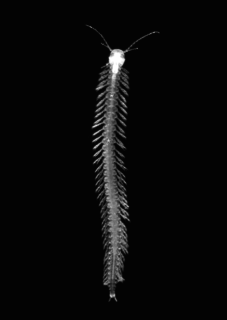
Remipedia is a class of blind crustaceans found in coastal aquifers which contain saline groundwater, with populations identified in almost every ocean basin so far explored, including in Australia, the Caribbean Sea, and the Atlantic Ocean. The first described remipede was the fossil Tesnusocaris goldichi. Since 1979, at least seventeen living species have been identified in subtropical regions around the world.

The Stenopodidea or boxer shrimps are a small group of decapod crustaceans. Often confused with shrimp or prawns, they are neither, but belong in a group closer to the reptant decapods, such as lobsters and crabs. They can be easily recognized by their third pereiopod, which is greatly enlarged, while for lobsters and crabs, it is the first pereiopod that is much bigger than the others. There are 71 extant species currently recognized, divided into 12 genera. Three fossil species are also recognized, each belonging to a separate genus. The earliest fossil assigned to the Stenopodidea is Devonostenopus pennsylvaniensis from the Devonian. Until D. pennsylvaniensis was discovered, the oldest known member of the group was Jilinicaris chinensis from the Late Cretaceous.
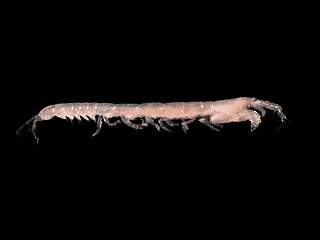
The crustacean order Tanaidacea make up a minor group within the class Malacostraca. There are about 940 species in this order.
Frederick Robert Schram is an American palaeontologist and carcinologist. He received his B.S. in biology from Loyola University Chicago in 1965, and a Ph.D. on palaeozoology from the University of Chicago in 1968 .
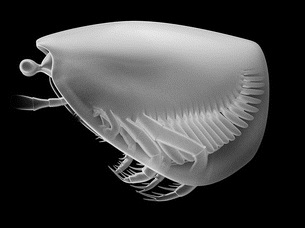
The Thylacocephala are a unique group of extinct arthropods, with possible crustacean affinities. As a class they have a short research history, having been erected in the early 1980s.
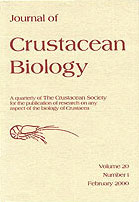
The Journal of Crustacean Biology is a quarterly peer-reviewed scientific journal in the field of carcinology. It is published by The Crustacean Society and Oxford University Press, and since 2015 the editor-in-chief has been Peter Castro. According to the Journal Citation Reports, its 2016 impact factor is 1.064.

Dromiacea is a group of crabs, ranked as a section. It contains 240 extant and nearly 300 extinct species. Where they are considered to form a monophyletic group, Dromiacea and two other groups of crabs, namely the Raninoida and Cyclodorippoidea, may be collected together into the Podotremata, each at the rank of subsection; morphological and molecular evidence argue against such a grouping.
Acadiocaris is an extinct genus of spelaeogriphacean crustacean that existed in Canada during the Upper Jurassic period. It was first named by Brooks in 1962, and contains the species Acadiocaris novascotica, named by Copeland in 1957 for the Canadian province of Nova Scotia. It is the only species in the family Acadiocarididae.
Aenigmacaris is an extinct genus of malacostracan crustacean, which includes the species Aenigmacaris cornigerum and Aenigmacaris minima. Their closest extant relatives are the mantis shrimp.
Aratidecthes is an extinct genus of crustaceans.
Crangopsis is an extinct genus of crustacean.
Joanellia is an extinct genus of Carboniferous crustaceans. It contains the species Joanellia lundi from lagoons in what is now Montana, and Joanellia elegans from near-shore marine deposits in northern England and southern Scotland.

Belotelson is a genus of crustaceans, in the extinct order Belotelsonidea, containing at least two species. It was first named by Packard in 1886 from material found in the Mazon Creek lagerstätte in Illinois. Its fossils have been found in Pennsylvanian age rocks.
Kellibrooksia is an extinct genus of crustacean in the order Hoplostraca from the Middle Pennsylvanian.
Waterstonella grantonensis is a species of fossil crustacean so distinct from other crustaceans that it has been placed in its own genus, Waterstonella, family, Waterstonellidae, and order, Waterstonellidea. It is named after Dr. Charles Waterstone, keeper of geology at the Royal Scottish Museum, while the specific epithet commemorates the location where the fossil was found, the Granton shrimp beds, near Edinburgh.
Eunephrops manningi, the banded lobster, is a species of lobster found in the West Indies. It was named in 1974 by carcinologist Lipke Holthuis after his friend and fellow carcinologist Raymond B. Manning.
Gampsurus is an extinct genus of shrimp in the order Decapoda. It existed in Germany during the Cretaceous period. It contains a single species, Gampsurus dubius.

Cyclida is an order of fossil arthropods that lived from the Carboniferous to the Cretaceous. Their classification is uncertain, but they are generally treated as a group of maxillopod crustaceans.
Funchalia is a genus of deep-water prawns of the family Penaeidae. Six species are currently recognised:
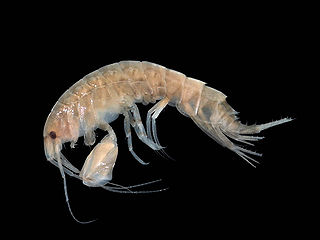
Crustaceans form a large, diverse arthropod taxon which includes such animals as crabs, lobsters, crayfish, shrimps, prawns, krill, woodlice, and barnacles. The crustacean group can be treated as a subphylum under the clade Mandibulata; because of recent molecular studies it is now well accepted that the crustacean group is paraphyletic, and comprises all animals in the clade Pancrustacea other than hexapods. Some crustaceans are more closely related to insects and the other hexapods than they are to certain other crustaceans.









